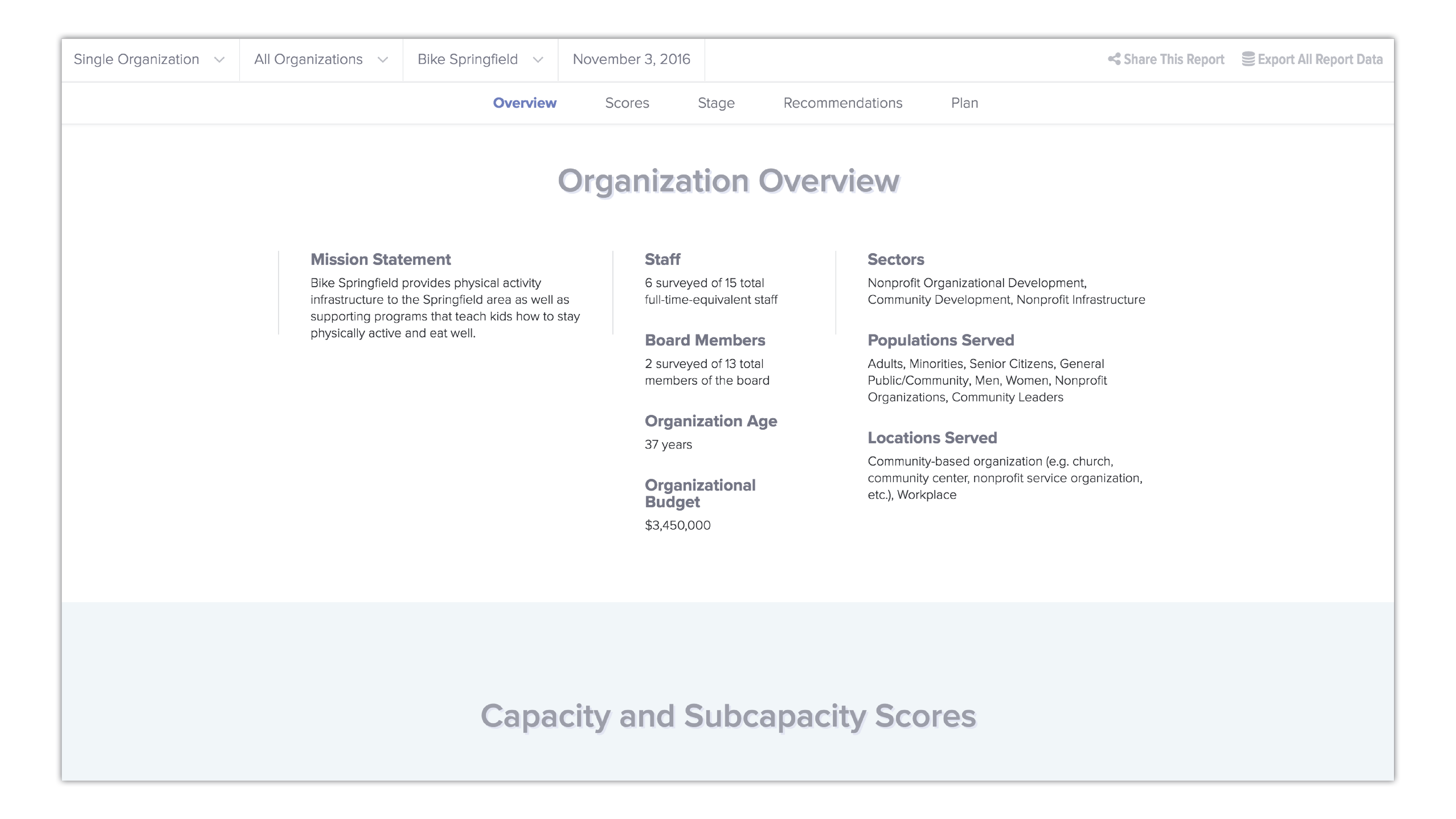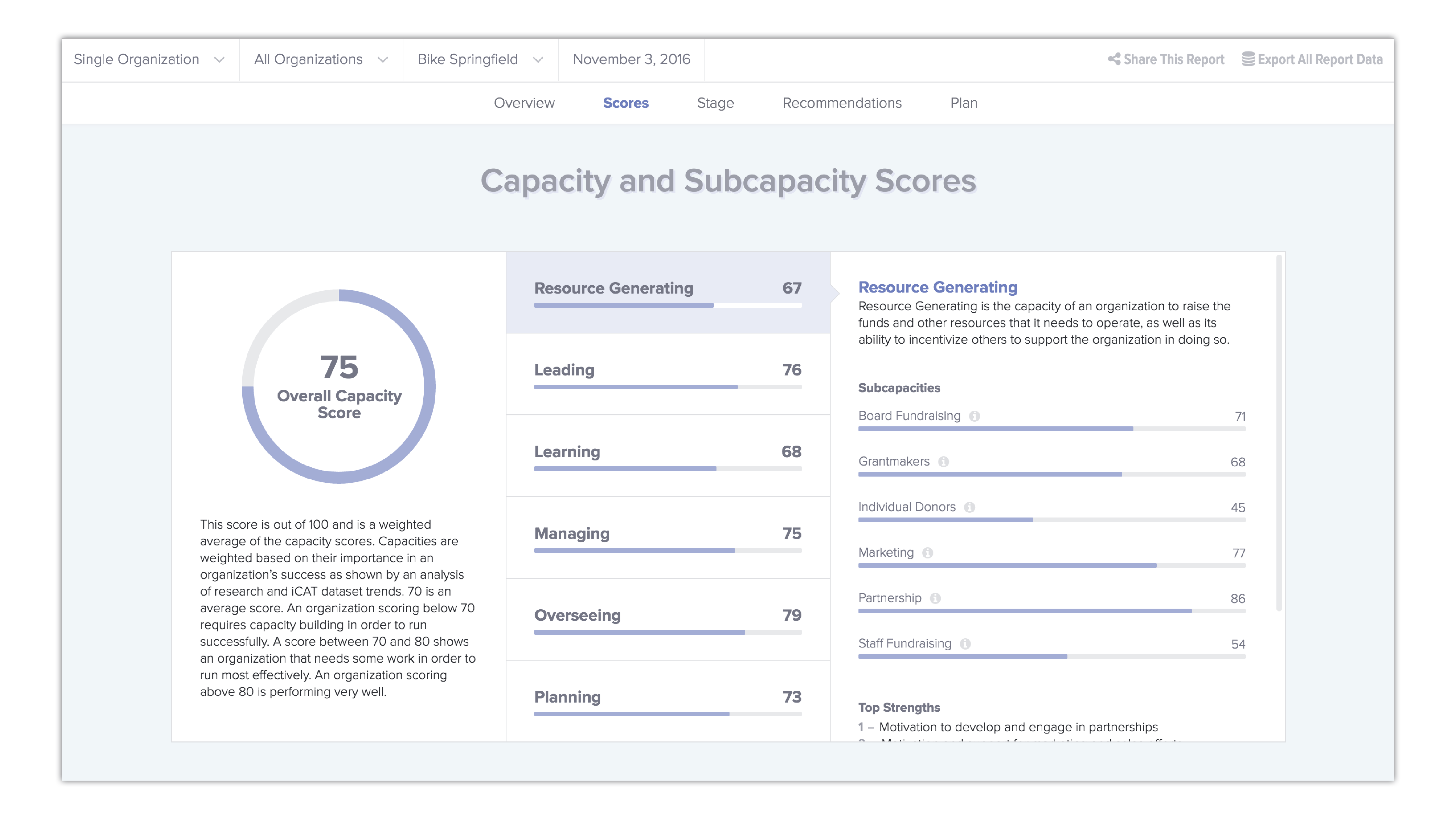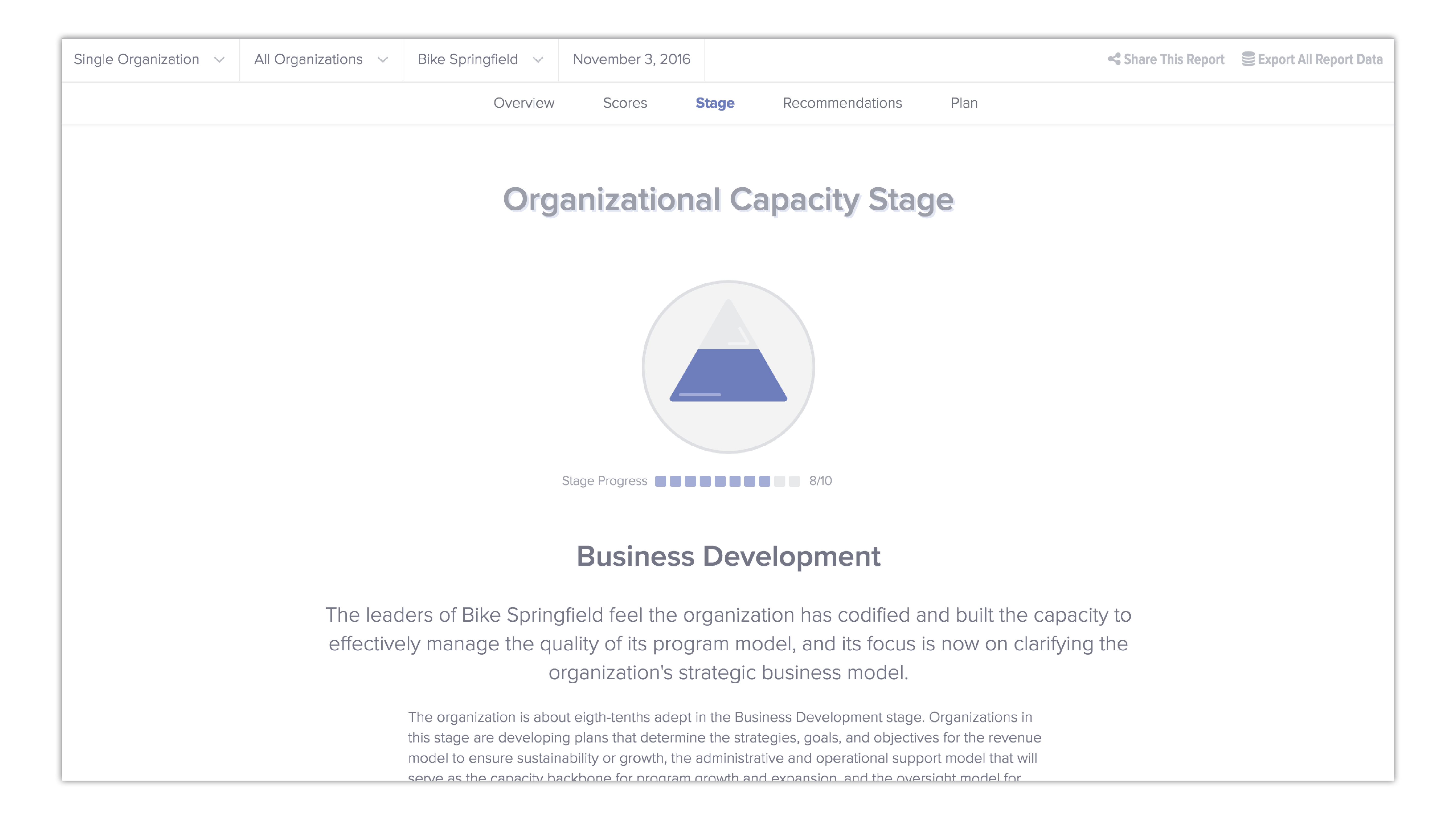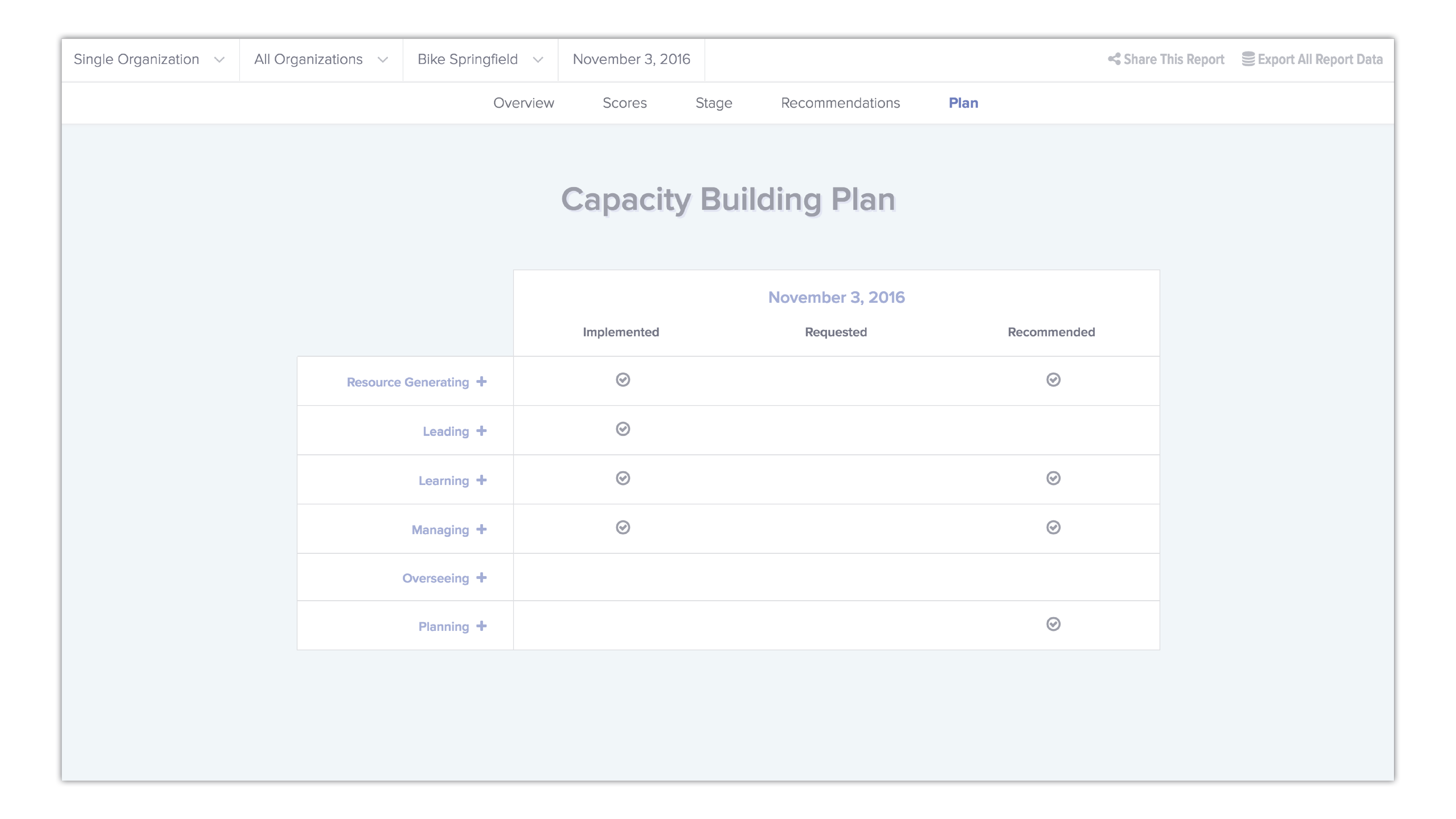Organization Overview

Capacity and Subcapacity Scores

Organizational Capacity Stage


Program Modeling
An organization in this stage is still focused on clarifying its mission and vision, with particular emphasis on building or refining its core program model. It is important to note that the term “program” refers to direct service programs and indirect programs and strategies, like policy, advocacy, community education, research, and other types of programs or strategies that are not direct, one-to-one interventions with the target population. An organization in the Program Modeling stage is focused on figuring out, codifying, and learning how to manage and evaluate the quality of its core programs. There are two types of organizations that can find themselves in the Program Modeling stage: (1) younger organizations that are still clarifying their mission work and (2) established organizations that have either struggled to codify for what and how they do their mission work or have encountered environmental changes in policies or funding streams that have caused the organization to significantly revise its core programs. Organizations in the Program Modeling stage should consider focusing on (1) clarifying and unifying everyone around the mission and vision, (2) codifying the program model, including creating all of the information, processes, tools, and manuals that will ensure quality implementation, (3) determining program performance criteria and management strategies to course correct, (4) developing methods, processes and tools for evaluating the success of programs, and (5) aligning the financial model and oversight with the resource needs of effective program implementation.
Business Development
Leaders of an organization in this stage feel the organization has codified and built the capacity to effectively manage the quality of its program model, and its focus is now on clarifying the organization’s strategic business model. Organizations in this stage are developing plans that determine the strategies, goals, and objectives for the revenue model to ensure sustainability or growth, the administrative and operational support model that will serve as the capacity backbone for program growth and expansion, and the oversight model for holding all leaders accountable for finances, mission progress, and impact. Organizations in the Business Development stage should consider focusing on (1) developing strategic and business plans, including determining metrics of success for key goals and objectives (2) determining the oversight model (i.e., leadership, decision-making and accountability model) that will ensure the timely implementation of strategies and tactics, (3) developing and implementing a reliable revenue generation model, and (4) developing and implementing an overall staff and volunteer management model that clarifies all position roles and responsibilities, establishes performance criteria, and decides upon the best talent recruitment, management and development methods, tools and processes.
Growth Management
Leaders of an organization in this stage believe the organization has built the capacity to grow in size, but that its programs have been stretched to their limit. This stage reflects an organization that has successfully built the capacity to strategically plan and generate resources, and it likely has a clear revenue model. That said, organizations in this stage have reached a level of growth capacity that appears to have stretched the organization’s program capacity to its limits, as evidenced by the leaders and managers perceiving that the organization could use more capacity for clarifying its mission work, evaluating the success of its programs, assessing the needs of the population being served/targeted, and/or further codifying and managing the performance of program implementation. Organizations in the Growth Management stage should consider focusing their work on (1) re-clarifying and unifying everyone around the mission and vision, (2) further codifying the program model, including creating all of the information, processes, tools, and manuals that will ensure quality implementation that matches the growth that the organization has achieved, (3) determining program performance criteria and management strategies to course correct, (4) developing methods, processes, and tools for evaluating the success of programs, and (5) aligning the financial model and oversight with the resource needs of effective program implementation.
Mission Advancement
Leaders of an organization in this stage believe the organization has developed the capacity to design, deliver, and manage its programs while measuring and ever-improving upon their impact. The organization also has the capacity to effectively develop, implement, assess, and course correct its strategic and resource development plans. The challenge for this stage is a making a choice of one or more of the following: (1) sustaining the organization’s impact work with the program and business capacity it currently has, (2) growing the program and business capacity in order to scale the mission work further, and/or (3) engaging in collaborations or partnerships that leverage its own assets and those of others in order to collectively move the needle on community impact. The need for an advanced level of oversight of the organization is a key focus for organizations in the Mission Advancement stage. Specifically, the organization will need to ensure that the board and executive team devote enough resources, support, know-how, and experience toward assessing and holding everyone accountable for the advancement of progress on strategic and business plan goals and objectives, the finances and financial model, and the achievement of measurable impact in the community. Undergirding this oversight is a need to continue investing in building the leadership and decision-making capacity of the organization.
Impact Advancement
Leaders of an organization in this stage believe the organization has developed the ability to deliver and scale programs while collaborating in a way that advances its mission work. This stage reflects an organization that has developed the capacity to design, deliver and manage its programs while measuring and ever-improving upon their impact; the capacity to effectively develop, implement, assess and course correct its strategic and resource development plans; and the capacity to engage in collaborative partnerships in order to advance the mission work. At this stage the organization has the capacity to be very effective, and the focus will likely be on leveraging its high capacity in order to maximize the achievement of measurable community impact, including filling any strategic gaps that the leaders agree upon. A key focus for organizations in the Impact Advancement stage is raising the bar on achieving community impact by strategically combining programmatic, organizational, and other business assets with the assets of key collaborators, collectives, or partnerships that attribute greater positive community change. This work will likely require a strategically-determined set of programs, projects, initiatives, research, policy work, and advocacy efforts.
Capacity Building Recommendations

Capacity Building Plan

